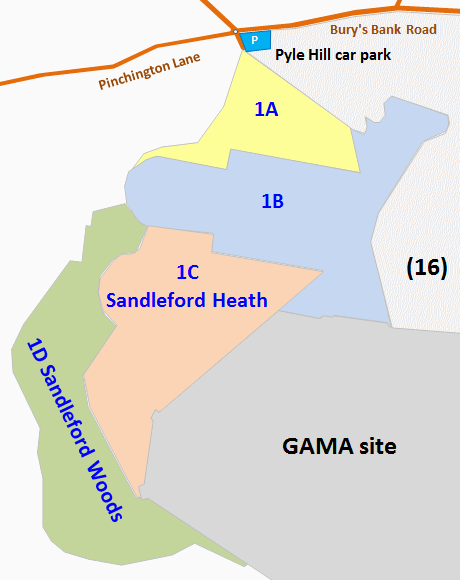
Compartment 1 is the western end of the common. It contains a mix of mature heath and woodland habitats, with some recently heavily disturbed areas. There are four subcompartments, with a total area of 34.2 ha. Subcompartment 1A is immediately south of the Pyle Hill car park and entrance onto the common. 1B includes the far western end of the former runway. 1C is an area of heathland known as Sandleford Heath, and 1D is Sandleford Woods. The majority of subcompartments 1A, 1C and 1D lie outside the former airbase. The whole compartment is available for grazing by cattle and Exmoor ponies.
General description and evaluation of ecology
This compartment contains diverse heathland communities ranging from pioneer to mature heath, which itself also contains scattered scrub, acid grassland patches and a good deal of bare ground. Species known to use the heath include woodlark, nightjar and reptiles. The compartment also contains mature (but not ancient) woodland and wood pasture, which are valuable for fungi and bats. Nest boxes haven also been placed here forming part of the formal monitoring. The woodland on the common boundary consists of an old wood-bank. This compartment also has potential for heathland restoration and re-creation, as it contains disturbed gravel from beneath the old runway and secondary birch woodland with relic heath flora. The northern end of compartment 1C and the western part of 1B are potentially suitable sites for the re-introduction of the silver-studded blue butterfly. Compartment 1B also contains some grazing exclusion zones which could warrant further study.
BAP habitats
- Lowland heathland (1B, 1C)
- Lowland beech and yew woodland (1D)
- Lowland dry acid grassland (1C)
Higher Level Stewardship
Options exist for subcompartments 1A, 1B and 1C.
- HO1 (maintenance of lowland heathland)
- HO2 (restoration of lowland heathland)
- HK6 (maintenance of species-rich, semi-natural grassland)
- HK7 (restoration of species-rich, semi-natural grassland)
Overall management objectives
Where mature or relic heathland exists this should be the priority habitat. The heath should ideally be maintained or opened up with a quantity of scrub and mature trees retained for diversity. It should also contain a diverse structure that can be created by mowing and scraping. Elsewhere bramble, gorse and scrub can develop on the grassland so long as it remains within limits. The woodland to the north will be minimally managed except for the control of rhododendron and sycamore, and any work arising from an annual tree safety inspection. The woodland to the south should be scalloped and cleared for the expansion of the heathland with mature trees retained as standard in-field trees.
Subcompartment 1A (4.1 ha)

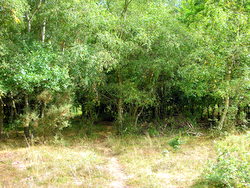
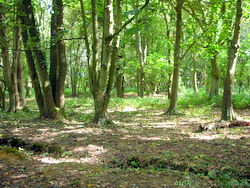
An area of secondary birch, oak and sycamore woodland also containing ash and rowan, with an understory of brambles. There are also areas of recently felled woodland with gorse, heather and acid grassland communities and regenerating birch scrub.
| Objective | Area | Method | Comments |
|---|---|---|---|
| 1A.1) Create a more diverse structured woodland by 2013. | Whole wooded area bounded by the main access tracks from Pyle Hill car park area. | Clear small glades by felling birch. Stack logs. Burn or stack brash where suitable and leave stumps to regenerate. Leave standing deadwood where safe. Along main path, minimal maintenance resulting from annual tree safety inspections. Create log piles for reptiles, invertebrates etc. Fence around yew to exclude cattle. |
Tolerate sycamore in this amenity woodland block.
Maintain birch, oak and sycamore woodland screen along main path edge in the triangle of woodland bounded by the main access tracks from Pyle Hill car park area. |
1A.2) Maintain existing heathland and acid grassland mosaic.HLS objectives |
Clearings on the south side and eastern end of the woodland screen. | Coppice degenerate gorse and dominant birch scrub. Treat birch stumps to prevent re-growth. Preserve heather and acid grassland in clearings on the south side and eastern end of woodland screen. Up to 0.25 ha per year. | Gorse management for Dartford warbler. |
| 1A.3) Increase areas of heathland and acid grassland communities where a relic flora remains under recent birch woodland. | The edge of the eastern and southern tree line. | Fell secondary woodland where relic heath flora exists to extend area of heath. Stumps should be treated and litter scraped in small sections to expose seed bank. Scallop edges to increase the length of the woodland/heathland boundary. Up to 0.25ha per year of the suitable areas. |
Subcompartment 1B (10.7 ha)
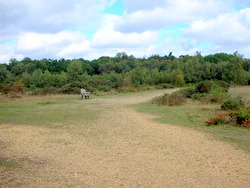
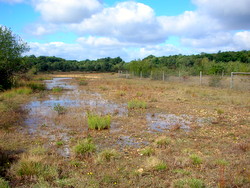
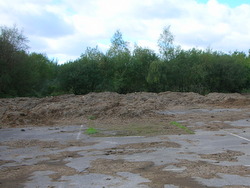
The areas of mature heathland have scattered gorse, bramble and birch scrub. The two strips either side of the old runway also contain mature (but mown and therefore uniform) heath, with a mosaic of flower and lichen rich acid grassland and some wet areas. There are also patches of rank neutral grassland with bramble scrub. Subcompartment 1B also has an area of excavated runway, which now has heather re-establishment, gorse, and extensive bare gravel. Plants of local importance include upright chickweed Moenchia erecta, small cudweed Filago minima, heath cudweed Gnaphalium uliginosum and bee orchid Ophrys apifera. There are also some notable lichens and bryophytes.
| Objective | Area | Method | Comments |
|---|---|---|---|
1B.1) Maintain existing heathland and acid grassland mosaic. Start diversifying structure by 2009.
HLS objectives |
Where heath and semi-natural grassland occurs in whole of subcompartment 1B. | Mow heath in strips over a 20 - 25 year rotation (up to 5% of heath area each year, preferably in 3 or more separate blocks). Collect and remove cuttings. Create small scrapes (1% of heath) for bare ground/gravel and pioneer heather regeneration. Control birch, gorse scrub and brambles using herbicides if required. Remove birch scrub and treat stumps, where it starts to invade dry heath. Up to 20% of the scrub area each year. Control patches of dense bramble where it spreads onto flower rich acid and neutral grassland. Start cutting up to 10% of the area of brambles per year by 2009. Restrict gorse establishment on the old runway to no more than 10% of the area. |
Maintain patches of bramble and gorse on the grassland for invertebrates, and nesting cover. Potential area for reintroduction of the silver-studded blue butterfly (See Appendix 5 Surveys & monitoring). |
1B.2) Continue to restore heath to areas of old runway.HLS objectives |
Spread heather cuttings with seed on suitable areas. Control birch, gorse scrub and brambles with cut and collect mower and use chemicals on birch stumps if required. Heather can be sourced from mowing elsewhere on the common. | Maintain distance from 'grazing exclusion' zones. | |
| 1B.3) Start creating and maintaining a diverse gorse structure in dominant stands by 2009. | Predominantly NE corner of subcompartment 1B. | Coppice sections of dense gorse on a rotation. Cut and remove using chainsaw or cut and collect mower. Allow to regenerate, or treat stumps as necessary. | Important for Dartford warbler. |
| 1B.4) Maintain ash and birch screen along the path. | Alongside path on western boundary. | Coppice a small section each year and allow to re-grow to maintain a thick screen. | Regrowth may need protection from deer and cattle. |
| 1B.5) Link compartments 1B and 1C by 2010. | South of 1B and North of 1C. | Clear small glades by removing birch and gorse between the two compartments. |
Subcompartment 1C (9.6 ha) Sandleford Heath
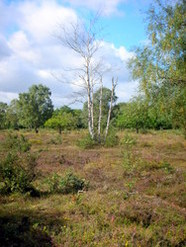
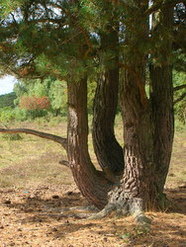
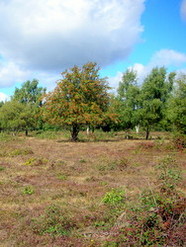

The large open area known as Sandleford Heath is predominantly mature dry heath with patches of acid grassland (characterised by purple moor grass Molinia caerulea), bracken and tall birch scrub. The structure varies as some large areas have been cut to provide seed for heath restoration elsewhere on the common which has left a uniform height and some rectangular patches have been dug to provide bare gravel for new heather with the arisings brought up to create south facing banks for insects and reptile habitat. There are also taller birch, pine and oak trees left for nightjar, tree pipit, and woodlark song posts. This area is a possible site for the reintroduction of the silver-studded blue butterfly.
| Objective | Area | Method | Comments |
|---|---|---|---|
1C.1) Maintain existing area of open heath and acid grassland mosaic and continue diversifying structure.
HLS objectives |
Open heath forming majority of 1C. | Mow heather in strips over a 20 - 25 year rotation. (Up to 5% of heath area each year, preferably 3 or more separate blocks.) Collect and remove cuttings. Create small scrapes for 1% bare ground and pioneer heather regeneration (look at creating scrapes within degenerate heather, scrub or bracken), with soil banked on northern side creating a south facing slope for invertebrates and reptiles. Control birch, gorse scrub and brambles using chemicals if required. Permit patches of dense birch scrub and brambles within the heathland to provide nesting cover for nightjar and song perches for tree pipit. Reduce the number of standard birch trees and increase standing dead wood. Ring-bark to create standing dead trees where suitable (not within 3 tree lengths of a path or track) otherwise fell and stack logs to create habitat pile. Treat stumps. |
See Appendix 7 Heathland management. Potential area for reintroduction of silver-studded blue butterfly (See Appendix 5 Surveys & monitoring). |
| 1C.2) Maintain woodland screen and diversify woodland/heath edge. | Around the edge of the heath alongside the GAMA site and along eastern path. | Scallop into woodland/heath edge. Remove arisings and allow stumps to re-grow to maintain screen and create thicker scrub layer. Increase the area of the open heath over subsequent years |
Transition scrub phase between woodland and heath is an important element of the heath. |
| 1C.3) Control bracken on the open heath by 2010 to prevent dominance, but permit bracken in the woodland edges. | Across whole of open heath but predominantly in southwestern corner. | Treat bracken. Follow up with removing bracken litter in following year. Cut bracken to reduce its vigour at woodland edges if relic heathland flora exists beneath. Spray bracken where it occurs more than 25 m from woodland edges. |
Subcompartment 1D (9.8 ha) Sandleford Woods
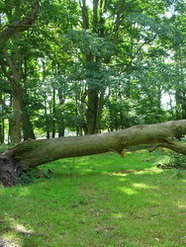

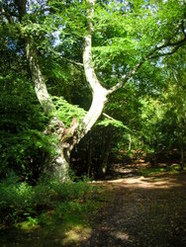

An area that begins on the plateau and covers the slopes that fall to the west and south of Sandleford Heath. On the south side it contains some very large oak, sweet chestnut, beech, hornbeam, and pine trees in what looks like a wood pasture setting. The rest of the plateau area contains thick secondary birch and oak woodland with bramble and bracken below. On the slopes the woodland is more mature with similar species. Some invasive rhododendron is establishing along the boundary with St. Gabriel's school.
| Objective | Area | Method | Comments |
|---|---|---|---|
| 1D.1) Maintain the wood pasture area, the mature woodland on the slopes and large mature trees around the boundary of the common. | On slopes and plateau. | Minimum intervention. Maintain good amounts of fallen and standing deadwood. Open small glades where appropriate and maintain standards. Glades initially can focus on areas of heath within woodland and link to main heath (1C) over time. Cut glades within the secondary birch woodland back to the top of the slope, predominantly where relic heath flora exists beneath. Up to 0.25ha per year. |
Remove yew regeneration outside fenced enclosures, by pulling seedlings. Alternatively fence new saplings against cattle. Cut back yew branches inside fenced enclosures to prevent cattle from browsing. |
| 1D.2) Increase area of open heath adjacent to compartment 1C and create a diverse age woodland/heath edge boundary. Initial clearance of woodland along the heathland edge has been undertaken, and will continue in 2011/12, by BBOWT as part of the West Berkshire Living Landscape project. This will involve removal of secondary woodland, predominantly young silver birch, to increase the heathland area. Subsequent maintenance will fall into this management plan. |
Southern and eastern edges of open heath. Top of slope runs up the middle of compartment. Eastern side to be cleared over time until it meets the open heath. |
Cut bays (scallops) in straight sections up to 1 scallop 50 m long and 25 m deep each year and preferably where heather exists in the ground layer. Treat stumps to prevent regrowth although some trees at the new woodland edge can be coppiced to create a scrubby successional layer at the heathland boundary. Cut and remove birch scrub and small trees. Stack logs to create habitat piles. Leave suitable mature trees to develop into standard in-field trees. |
Start to create bays next to heathland and continue each year to top of slope. Link the glades cleared within the woodland to the open heath. |
| 1D.3) Prevent spread of, and if possible eradicate, undesirable species such as sycamore, rhododendron, gaultheria spp. and Japanese knotweed. Keep yew regeneration confined to the fenced-off enclosures. | Whole of subcompartment 1D. | Cut to base and treat stumps. Remove or burn on site. |